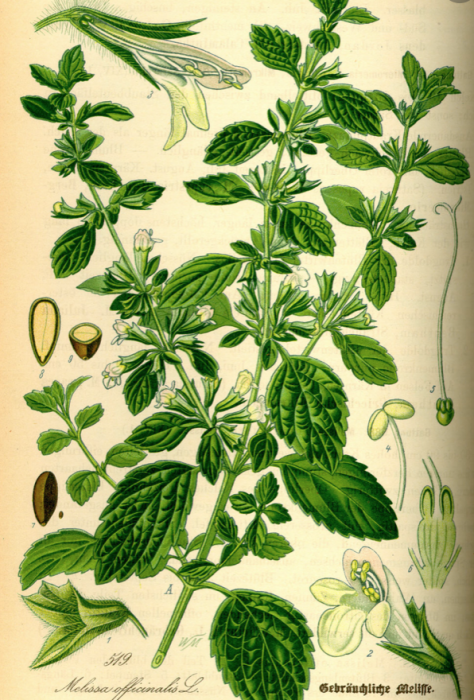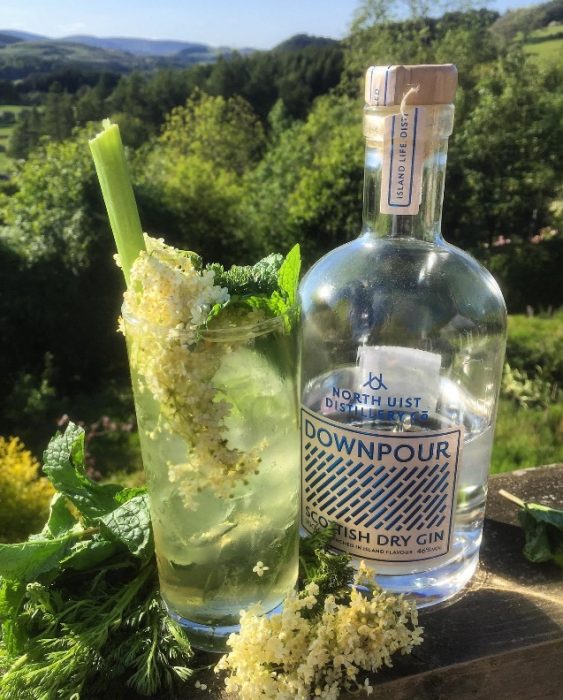Lemon Balm – Identification, Edibility, Distribution, Ecology, Recipes
Melissa officinalis
AKA Common balm, Bee Balm, Sweet Balm, Melissa

- Edibility – 5/5 – Strongly aromatic, reminiscent of sweet lemon, with menthol qualities (without actually being “minty”). The whole plant is edible, though its the tender leaves you are after. Lemon balm has a long history of a wide array herbal medicine uses, in particular for soothing, calming and raising the spirit – just one smell of the crushed leaves does all of these for me. It is most commonly used to make an excellent tea, but is also great for adding to salads; sauces for fish; flavouring ice creams and sorbets; infusing into vinegars and shrubs; and fabulous muddled in cocktails (see below for lots of boozy ideas). A sprig makes a brilliant garnish in a G&T, instead of lemon from half way around the world. It dries well, retaining much of its flavour, but never so good as freshly picked in July.
- Identification – 4/5 – Lemon balm is a member of the mint (lamiaceae) family, so easily identified by its square stems (twirl them round in your fingers to feel this), oppositely paired leaves, and flowers that hug the stem. As no members of the mint family are toxic, you are on safe ground here. You may well visually mistake this for other mints, but as soon as you crush and smell the leaves, the wonderful lemony aroma should confirm it as lemon balm.
- Distribution – 3/5 – Naturalised in the UK from it home around the Mediterranean. While lemon balm is not uncommon in the wild, it is generally as a garden escapee – at least in Scotland. It is more common in the wild further South. Like most mints it spreads prolifically if given half a chance, but not known to be a problematic. Personally I can’t get enough of the stuff! 🙂
- Season – Best May to September. Perennial, though offering pretty sparse pickings December – March
- Habitat – Most commonly encountered in herb gardens, but often ‘jumping the hedge’ to make a wild home in hedgerows, wood edges, waste ground
- Ecology – Pollinated by bees and other flying insects. 16th century herbalist John Gerard noted that “It is profitably planted where bees are kept. The hives of bees being rubbed with the leaves of bawme, causeth the bees to keep together, and causeth others to come with them.”

Lemon Balm
Foragers use the word “wild” a lot. But quite often “feral” – in a wild state, especially after escape from captivity or domestication – is a better adjective. Such is the case with lemon balm, and I am extremely grateful to careless gardeners who have allowed it to jump the wall join the hedgerow. To be honest, I don’t find much in the wild in SW Scotland where I live, and am extremely grateful to Mrs (not-so) Wildfood for planting it in our garden.
Lemon balm contains a class of chemicals known as terpenes (notably citronellal), which are also present in citrus fruits and conifers (notably juniper), so it has a perfect affinity with gin. It also contains tannins, and eugenol, which is responsible for giving wood avens roots their clove-like aromatic resonance.

Wild Mojinto
Muddle lemon balm & wood sorrel with a little sugar and crab apple verjus, add cracked ice, gin & soda to taste.
This combination of heady and easy-to-infuse aromatics lend themselves incredibly well to boozy concoctions. A mere sprig in gin and tonic adds all the lemon waft you need without the air miles. Muddle the leaves, perhaps with a little sorrel, for mojitos (or mojintos). It is also great for making botanical champagne, and is a natural partner for elderflowers which are at their height just as lemon balm gets near its summer best. I often add it to my home made vermouths. Perhaps best of all is to make it into a shrub.
Here is a rundown of how I like to work with it in the kitchen/bar, with brief instructions:
- Raw – Scatter in salad, on puddings or as a garnish.
- Syrup – infuse into a 1:1 sugar:water syrup by gently heating. Don’t boil. Cool in sterilised jars. Keeps in fridge for a couple of weeks. Pour on puddings. A great cocktail ingredient.
- Cordial – add lemon juice, crab apple juice, citric acid or the infused vinegar described below, to your syrup, to taste. This improves its keeping qualities and adds a pleasing sharpness. Drink as diluting cordial. Makes a great gimlet.
- Jelly – Once you’ve made a syrup or cordial, this can be used to make flavoured jelly.
- Vinegar – All mints love to pour their flavour into vinegar. Infuse leaves straight into cold apple cider vinegar. Leave a week. Strain. Use in salad dressings, or as a base for a pickling liquor.
- Shrub – Mix your lemon balm vinegar with your lemon balm cordial or syrup, to make a shrub. Or return it to its bee roots by mixing it with honey to make an oxymel. These are great for giving gentle acidity and structure to cocktails.
- Liqueur – Infuse into vodka for no more than 3 days. Strain. Blend with cordial/syrup/shrub to taste, to make a liqueur. Add to gin!
- Champagne – you just need water, sugar and a bit of vinegar. See my recipe for elderflower champagne here, and just sub in, or embellish with, lemon balm leaves. A fabulous mixer for gin.

The Elderbalm
70ml Downpour Gin
35ml Elderflower limoncello
35ml Dry vermouth
15ml Pineapple weed shrub
Muddle with lemon balm
Splash of lemon balm champagne to taste.
Garnish with lemon balm and elderflowers in such a way as to smell them as you drink it through an angelica stem straw (my favourite plant straw on account of its bitter aromatic contribution, and its devil-like cross section
You Might also be interested in:
2 Comments
How long does lemon balm aerial part stay in your system? Could they cause u to fail a drug test thanks !
I live in SE Eng, and two large patches of this spring up every year beneath a cherry tree. I was astonished when I first encountered it owing to the intense lemon aroma – a lovely herb. I like the recipe suggestions too!